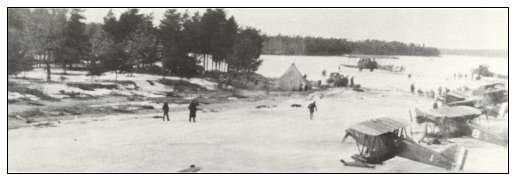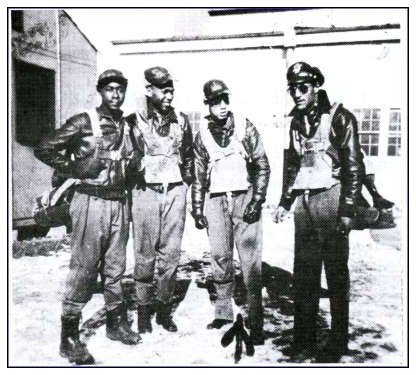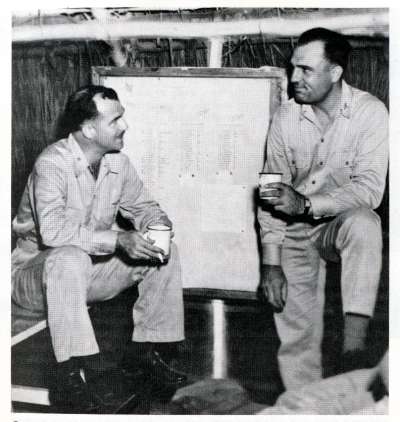The site of Wurtsmith Air Force Base is located 2 miles Northwest of Oscoda, Michigan, about 150 miles North of Detroit. The popular legend, supported by interviews and other historical documents, is that Wurtsmith was established as the direct result of a fishing trip by Lt. Ennis Whitehead (later Lt. Gen. Whitehead, commander of the Fifth and Far Eastern Air Forces during and after World War II). The brother of a local banker invited the lieutenant to come to Oscoda to fish Van Ettan Lake after fishing with Whitehead in Lake St. Clair near Mt. Clemens, about 10 miles from Detroit.

Curtiss Jennys of the First Pursuit Group, equipped with skies, land on Van Etten Lake (1925)
|
When Lieutenant Whitehead saw the lake and the surrounding area, he was impressed. He figured that if a strip of land were cleared along the lake, it would make an ideal gunnery range, just what his unit at Selfridge Army Air Field needed. They had been forced out of their established range on Lake St. Clair by increasing boat traffic and were looking for another suitable site to establish no only a gunnery range but a place where the young Army Air corps could come and test aircraft, maintenance procedures and equipment during cold weather.
 Members of the 332nd Fighter Group, early June 1943, left to right: Mac Ross, James R. Polinghorne, John Leahr, Harold E. Sawer Members of the 332nd Fighter Group, early June 1943, left to right: Mac Ross, James R. Polinghorne, John Leahr, Harold E. Sawer
|
Whitehead took his idea back to his squadron commander, then-Major Carl Spaatz, who came up to look the area over for himself. He an Major Thomas Lamphier, his second in command, rode up in a side-car motorcycle to survey the area. They liked it so much that they took the proposal to build a gunnery range to the townspeople of Oscoda.
In July 1911 a terrible fire destroyed over 600 buildings in Oscoda and both of the industries that contributed the build of the economy to the area: two lumber mills and a cannery. With the loss of these industries, the area's population dwindled from nearly 20,000 to 1,000.
Representatives of those remaining citizens heard "Tooey" Spaatz's proposal to clear an area. They raised $600 to clear the land immediately so Army operations could start.
The base was first named in 1924 after Capt. Bert E. Skeel, a World War I pilot who was killed in an air race at Wilber Wright Field, Ohio, (now Wright-Patterson AFB) on Oct. 24, 1924. The base retained the name of Camp Skeel until August of 1942 when, upon completion of three runways, connecting taxiways, and apron, it was renamed Oscoda Army Air Field.
Oscoda was the home of the 100th Pursuit Squadron, the famous black fighter unit, the "Black Panthers," of World War II fame, from April to July 1943.
On Jan. 13, 1948 all Army Air Fields became Air Force bases after the establishment of the Air Force. Oscoda's base remained with that name until it was redesignated in ceremonies on July 4, 1953, in honor of Maj. Gen. Paul Bernard Wurtsmith. General Wurtsmith was a hero of action, commanding the Thirteenth Air Force in the South Pacific during World War II.

General Paul Wurtsmith (left), then commander of the 5th Air Force Fighter Command, talking with Colonel Richard Legg of the 35th Figher Group.
|
The Detroit native was killed Sept. 13, 1946 when his B-25 crashed on Cold Mountain near Asheville, North Carolina during a training flight.
Wurtsmith became home to the 412th Fighter Group (formerly the 527th Air Defense Group), parent organization of the 63rd Fighter Interceptor Squadron. The unit was redesignated the 445nd Fighter Interceptor Squadron on Aug. 18, 1955, until those units were moved or redesignated. The base was turned over to the Strategic Air Command on April 1, 1960. On July 15, 1960, the 920th Air Refueling Squadron was transferred from the 7th Bomb Wing and 11 KC-135A tankers and 16 mission-ready crews arrived at Wurtsmith, the first SAC flying unit to be stationed at the base.
The base population was around 1,000 in April 1960, but had rapidly outgrown the 107 family housing units then available. Wurtsmith's base population peaked at about 3,500 military and civilian employees and more than 3,000 family members.
Wurtsmith AFB was deactivated on June 15th 1993. The end of an era...